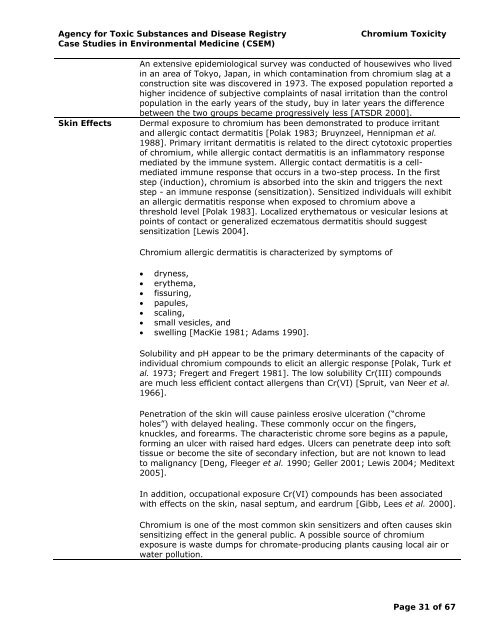(Cr) Toxicity | ATSDR - CSEM - Agency for Toxic Substances and ...
(Cr) Toxicity | ATSDR - CSEM - Agency for Toxic Substances and ...
(Cr) Toxicity | ATSDR - CSEM - Agency for Toxic Substances and ...
You also want an ePaper? Increase the reach of your titles
YUMPU automatically turns print PDFs into web optimized ePapers that Google loves.
<strong>Agency</strong> <strong>for</strong> <strong>Toxic</strong> <strong>Substances</strong> <strong>and</strong> Disease Registry Chromium <strong><strong>Toxic</strong>ity</strong><br />
Case Studies in Environmental Medicine (<strong>CSEM</strong>)<br />
An extensive epidemiological survey was conducted of housewives who lived<br />
in an area of Tokyo, Japan, in which contamination from chromium slag at a<br />
construction site was discovered in 1973. The exposed population reported a<br />
higher incidence of subjective complaints of nasal irritation than the control<br />
population in the early years of the study, buy in later years the difference<br />
between the two groups became progressively less [<strong>ATSDR</strong> 2000].<br />
Skin Effects Dermal exposure to chromium has been demonstrated to produce irritant<br />
<strong>and</strong> allergic contact dermatitis [Polak 1983; Bruynzeel, Hennipman et al.<br />
1988]. Primary irritant dermatitis is related to the direct cytotoxic properties<br />
of chromium, while allergic contact dermatitis is an inflammatory response<br />
mediated by the immune system. Allergic contact dermatitis is a cellmediated<br />
immune response that occurs in a two-step process. In the first<br />
step (induction), chromium is absorbed into the skin <strong>and</strong> triggers the next<br />
step - an immune response (sensitization). Sensitized individuals will exhibit<br />
an allergic dermatitis response when exposed to chromium above a<br />
threshold level [Polak 1983]. Localized erythematous or vesicular lesions at<br />
points of contact or generalized eczematous dermatitis should suggest<br />
sensitization [Lewis 2004].<br />
Chromium allergic dermatitis is characterized by symptoms of<br />
• dryness,<br />
• erythema,<br />
• fissuring,<br />
• papules,<br />
• scaling,<br />
• small vesicles, <strong>and</strong><br />
• swelling [MacKie 1981; Adams 1990].<br />
Solubility <strong>and</strong> pH appear to be the primary determinants of the capacity of<br />
individual chromium compounds to elicit an allergic response [Polak, Turk et<br />
al. 1973; Fregert <strong>and</strong> Fregert 1981]. The low solubility <strong>Cr</strong>(III) compounds<br />
are much less efficient contact allergens than <strong>Cr</strong>(VI) [Spruit, van Neer et al.<br />
1966].<br />
Penetration of the skin will cause painless erosive ulceration (“chrome<br />
holes”) with delayed healing. These commonly occur on the fingers,<br />
knuckles, <strong>and</strong> <strong>for</strong>earms. The characteristic chrome sore begins as a papule,<br />
<strong>for</strong>ming an ulcer with raised hard edges. Ulcers can penetrate deep into soft<br />
tissue or become the site of secondary infection, but are not known to lead<br />
to malignancy [Deng, Fleeger et al. 1990; Geller 2001; Lewis 2004; Meditext<br />
2005].<br />
In addition, occupational exposure <strong>Cr</strong>(VI) compounds has been associated<br />
with effects on the skin, nasal septum, <strong>and</strong> eardrum [Gibb, Lees et al. 2000].<br />
Chromium is one of the most common skin sensitizers <strong>and</strong> often causes skin<br />
sensitizing effect in the general public. A possible source of chromium<br />
exposure is waste dumps <strong>for</strong> chromate-producing plants causing local air or<br />
water pollution.<br />
Page 31 of 67

















